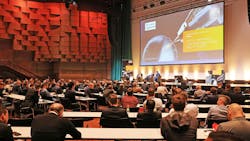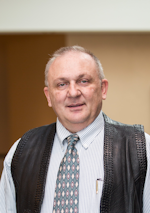I first attended the International Laser Technology Congress (AKL) conference in 2012 and traveled there with/was tutored by our former colleague David Belforte, who had been attending this conference for many years—probably since the beginning—and who always gave a very well attended talk on the U.S. Marketplace for Lasers. We traveled together again for the next conference and then Dave stopped traveling, so for the next two conferences I gave the Marketplace talk for Dave (with a few additions of my own to add perspective). Then came 2020 and COVID. I think I was one of the first to pull out because I had seen things coming at Photonics West and I sensed that this was going to be historic. Shortly thereafter, of course the flood gates opened and eventually the conference was canceled. So, even though the conference has continued, I have not had the opportunity to attend until this year when the organizers invited me. Here are some of my thoughts.
First, the venue is the same, but the faces are different—which is probably a good thing. A dozen years ago, I think I knew at least 50% of the people in attendance, many of them very well. This year, I only knew a fraction of the people. On the negative side, many of the ‘old faces’ are gone by either retirement (the lucky ones?), changing industry, or deceased. On the positive side, I met a lot of real bright younger folks who are doing cool research and building dynamic young companies. Much of this company building activity comes directly out of the institutes in Germany such as the Fraunhofer Institutes. Fraunhofer Institute for Laser Technology (ILT) is the main sponsor of the event, along with 7 other supporting organizations.
Some other statistics: There were 525 attendees this year from 21 countries, 80 of whom were speakers, and there were 58 exhibitors spread about two floors of the hall. There is ample time between sessions and at the Thursday night event to have as much up-close-and-personal time with any vendor anyone chooses. At this venue, most of the people are actually users and potential customers, unlike a large venue like Photonics West or the Laser Munich show where most of the people are just ‘kicking tires.’ As a vendor, you have to be careful not to waste time on non-productive meetings. The cost of attending this conference is high—around $2000, but the highly pre-qualified leads should be worth the cost.
One thing this conference features is the live lab demonstration tour where visitors can see a host of laser technologies in action or being developed. Over 60 stations were set up during this year’s event and a four-hour window was set aside during Thursday afternoon to bus to the University and back, before attending a social event in the exhibitor lounge. If you attend this conference, you will definitely be fed well and you will be kept busy from 8 in the morning until 11 at night—but it is well worth it for the chance to personally interact with such a talented group of laser scientists and business entrepreneurs. It is a high-level technical conference, with many of the talks in German (translation available if needed), but if someone is serious about implementing new lasers and new technology into new applications, this is the place to be.
This year, special emphasis was placed on the transformative impact of AI on the laser industry and the emergence of new business models. The German government especially is also funding investigation of laser fusion energy generation and ILT is at the forefront of that effort. There were a few sessions and a number of talks on these topics and—showing my age, I am sure—I found most of this stuff to be tedious and boring. I am sure it is very important, but hard for an old guy like me to get excited about. I was told my one old-timer that, for about 20 years, you could get money for almost anything from the German government as long as your research proposal said LASER on it. Now, nobody gets any funding unless it has AI or ENERGY on it. So, I guess it is a good call to combine both!
I don’t have space to go into detail about the talks and proceedings, but the speakers are listed online and most are happy to respond to questions. There are companies like Lambda Physik (Coherent) talking about HUGE excimer lasers and extremely complicated optics used primarily for the display industry. I worked for Lambda Physik in the 1980s and I never expected excimer lasers to be such giants of industrial laser processing. There are also smaller companies presenting their research and this is really where most of the individual innovation (as opposed to institutional innovation) occurs. I would like to mention two:
First is a company called cleanLASER. I did some investigation on my own prior to the Wednesday night Awards ceremony in the Great Coronation Hall at the Aachen town center, and I thought that of the three candidates that were nominated for the award, this was the one that would probably win. I was correct—they were awarded the first-place prize, beating out two other very competitive companies. This company uses lasers for high-speed sorting of metals in recycling centers—a very practical use and one that affects everyone who generates garbage. Metals are ripped into chunks and these chunks are then fed down a belt where lasers identify the metal content (with very high accuracy) and then sort the pieces into the various bins. This is all done at very high speeds to make the sorting process economically feasible. I talked to their CEO, Edwin Buechter, after the award and he told me that he thinks this technology may be adapted worldwide and becomes more feasible as the price of metals goes up.
The second is a company that I have had personal relations with and have watched grow over the years—LightFab. I first heard about selective laser etching (SLE) at an ICALEO conference when one of the ILT students working on her Ph.D. gave a talk. I thought it was really interesting and at the next AKL conference, I was able to see the process in action and also talk to and get to know the rest of the SLE team members. Several of these researchers then left the lab for the University ‘incubation center’ and formed LightFab. They recently outgrew that facility and they not only have a dedicated facility outside of downtown Aachen, but they are in the process of opening a U.S. facility to better service the growing U.S. market. I have seen a number of these small companies incubate from ILT and form small companies that either grow into larger companies or are bought up by the really big companies. I can’t think of any that have totally failed, so this incubation strategy is obviously effective.
The next AKL is scheduled for April 2026. Mark it on your calendar!

